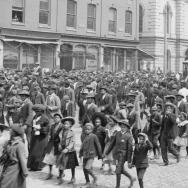In 1865, Congress set up a bank for newly emancipated Black Americans to help accelerate their economic empowerment. The Freedman’s Savings and Trust Company opened in New York, built headquarters in Washington, D.C. and established 37 more branches in quick succession across 17 states.
In its nine years of existence, the bank had a measurably positive effect on its customers. According to recent research by Chicago Booth’s Constantine Yannelis and Babson College’s Luke C. D. Stein, Freedman’s Bank account holders were more likely to be literate, attend schools, work, have higher incomes and own more real estate.
But the bank’s records also highlight the devastating effects wrought by financial failure, and provide a window into the country’s long history of exclusion and racism—including the persistent racial wealth gap and the lingering suspicion that many Black Americans hold toward financial institutions.
“It seems likely that the collapse of the Freedman’s Bank and the loss of savings has contributed to an intergenerational mistrust of banks,” Yannelis said.
Finding new opportunity
An assistant professor at the Booth School of Business and an expert in household finance, Yannelis visited the U.S. Treasury in fall 2018, but was rerouted from the main entrance due to a temporary security issue. On his detour, he came upon an annex that two years earlier had been renamed the Freedman’s Bank Building. Yannelis looked it up.
In her 2017 book The Color of Money: Black Banks and the Racial Wealth Gap, legal scholar Mehrsa Baradaran explains how the government originally proposed distributing land to people who had been enslaved, but faced a violent backlash from Southern whites. “Instead of land, freed slaves got rights that they could not use due to their economic and political status at the bottom rung of society,” writes Baradaran, a law professor at the University of California, Irvine. “They also got a savings bank, which was another form of diversion that would be repeated in the next century.”
Customers could open an account with as little as 5 cents, and received interest on deposits of $1 or more. Most deposits were small, less than $60 on average. More than 100,000 people became customers—farmers, cooks, barbers, nurses, carpenters—likely saving some of their very first paychecks.
In the bank’s archives, Stein and Yannelis saw an opportunity to study the effects of financial inclusion. Previous research had examined such effects in developing countries, but the Freedman’s Bank records offered a trove of data about Black Americans who essentially gained access to a financial institution overnight. Because branches opened at different times, it was possible to isolate effects in individual communities.
Stein and Yannelis analyzed surviving account-register records that had been microfilmed by the National Archives and later digitized in CD-ROM format by FamilySearch, a nonprofit genealogy association. They obtained data from 107,197 accounts across 27 Freedman’s Bank branches. After also accounting for family members who lived with an account holder, they totaled 483,082 individuals—roughly 12% of the Black population in the American South in 1870. They then lined these records up with a sample from the 1870 census containing information on schooling, literacy, employment and wealth among Black Americans.
The Freedman’s Bank, they determined, had a small but significant impact on the economic well-being and outlook of its account holders. Individuals in households with an account were 1 percentage point more likely to be literate and to attend schools. The same individuals were 2 percentage points more likely to work and to have higher incomes than their peers.
Having an account may have allowed individuals to save to make large purchases, such as a plot of land; to invest in workers; or to open a business. It also may have helped them overcome challenges associated with irregular income and shocks—often tied to fickle agricultural harvests—by providing a place to make consistent, recurring payments and save up a cash cushion.
The researchers found that those effects did not extend to white households near bank branches, nor to people who lived close to planned-but-never-opened branches. They also found larger effects for people who opened accounts earlier than people who started banking later.
Because it offered financial services to an unbanked population, the Freedman’s Bank had real impact for Black American individuals and households. By examining county-level vote shares in the 1868 congressional elections, Stein and Yannelis found corroborative evidence that the mere presence of a bank branch drove better school attendance, higher literacy and property value, and more employment and income.
Lasting mistrust
The Freedman’s Bank did not last. Despite being founded as an institution dedicated to savings, the bank soon invested its depositors’ hard-earned money into risky railroad companies and real estate. Its coffers were largely co-opted by the First National Bank, which offloaded its liabilities onto the Freedman’s Bank books with no objection from the latter’s all-white trustees.
The Panic of 1873 was a death knell, as real-estate prices fell, loans went bad and depositors demanded their money back. Social reformer Frederick Douglass was elected the bank’s president in a bid to save it, but he quickly became aware of the bank’s dire conditions and turned to Congress. On June 29, 1874, trustees voted to shutter the bank—leaving more than 60,000 depositors with nearly $3 million in losses. The Freedman’s Bank headquarters were torn down in 1899, replaced in 1919 by what would become the Treasury annex.
While opening Freedman’s Bank branches seemed to have generated positive effects, closing them generated negatives ones. “If the government and the philanthropists’ purpose was to teach the freed slaves thrift and responsibility, the lesson they actually learned was to distrust the government and philanthropists,” Baradaran writes in The Color of Money.
The research by Stein and Yannelis further bolsters the argument that the Freedman’s Bank failure did long-term damage to financial trust. When they looked specifically at counties that once had a Freedman’s Bank branch, using data from the 2017 Federal Deposit Insurance Corporation’s National Survey of Unbanked and Underbanked Households, they found that Black residents “are more likely to list mistrust of financial institutions as a reason for being unbanked—an association that is not present for white Americans,” Yannelis said.
Chicago Booth’s Richard Hornbeck and Louisiana State University’s Daniel Keniston are also studying the Freedman’s Bank—exploring how its collapse, including the funds lost by depositors, affected depositor households and their descendants. “This may also provide some insight into how African American families would have fared differently if those particular families had received some financial transfers in the immediate aftermath of slavery,” said Hornbeck, an economic historian and applied micro-economist who serves as the V. Duane Rath Professor at Chicago Booth.
Hornbeck and Keniston are merging several data sets that record how much money people had deposited in the Freedman’s Bank at the time of its collapse and what each family was reimbursed over the following decades. The researchers are tracking depositors in the Freedman’s Bank, and their descendants, from 1870 through 1940, the most-recent publicly available full census data. This project is ongoing.
Citation: “Financial Inclusion, Human Capital, and Wealth Accumulation: Evidence from the Freedman’s Savings Bank,” Stein and Yannelis, The Review of Financial Studies, Feb. 10, 2020. DOI: http://10.1093/rfs/hhaa013
—Excerpted and adapted from a story written by Áine Doris for Chicago Booth Review. Read more at the CBR website.

